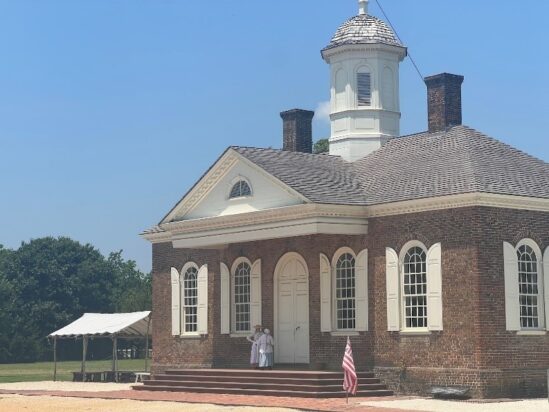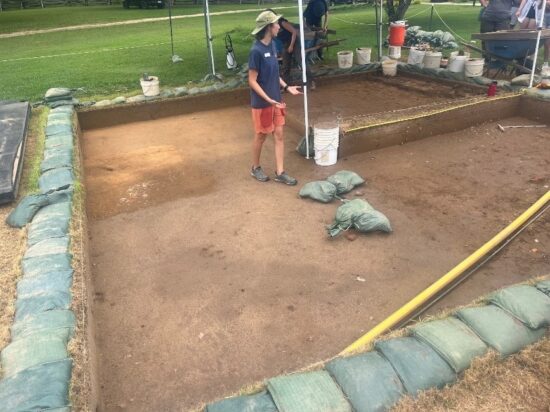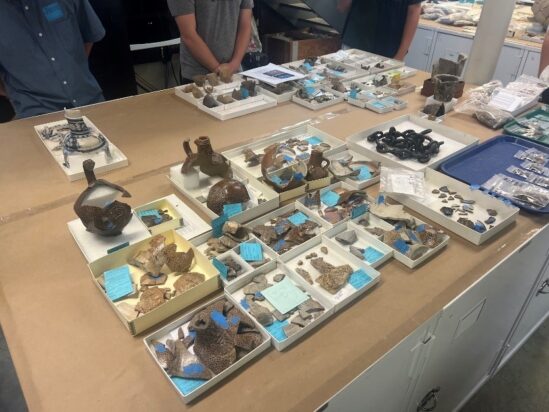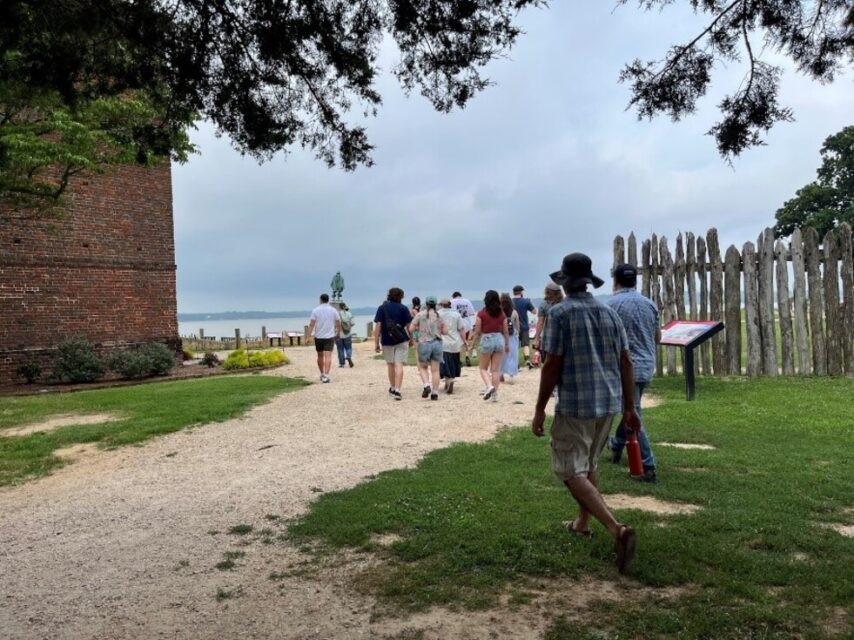Archaeology Blog
2025 Field School Week 4 (Part Two)
By: Sam Brown and Quinn Fergusson
Hi everyone! This past week, after many days hard at work on the grounds of Poplar Forest, the archaeology field school went on a spectacular two-day field trip to the Tidewater region! Here, we had the opportunity to explore Colonial Williamsburg and Historic Jamestowne, two incredible places from early American colonial history. Throughout our visits, the staff and professionals at work provided in-depth, behind-the-scenes looks at the amazing archaeological work being done at both destinations.
First up, the trip to Colonial Williamsburg! What begins as an early Thursday morning, leaving from Lynchburg, ends at the DeWitt Wallace Museum. Upon arriving in Williamsburg we are introduced to their new archaeology buildings and current plans, as well as blistering heat; however, this did not stop us from enjoying our exploration. Walking along, we are introduced to an open field currently identified as “Custis Square”, a property owned by one of the richest men in Virginia at the time, John Custis IV. This area had his home, some outbuildings, and a vast garden that would later be important for interpretation to the public. Continuing, we come across a very significant area of Colonial Williamsburg, Nassau Street, which housed the site of a Baptist Church established by enslaved and free African American people, one of the first in the country. The church building has been altered and moved several times, as well as destroyed once by a storm in the 1830s. A gravesite is located adjacent to the historic church site with over 60 graves resting within it. Efforts to identify those who occupied the graves, by archaeologists and other specialists, have worked in collaboration with the descendant community to provide additional evidence that the gravesite is composed of individuals of African descent from the nineteenth century. CW has worked with members of the First Baptist Church congregation on Scotland Street (descendants of the original congregation), to help identify and restore this area. The Bray School is another significant location on Nassau Street, which was created in the 1700s and taught roughly 300 enslaved children during 1760-1765. This area showed the strong connection Colonial Williamsburg has to the enslaved people who inhabited and the African American community who lived there into the 20th century. Next, we visit a plot of land which was owned by the aforementioned Custis and rented out by a man named Peter Scott, a popular furniture maker at the time, who used his skills as a transaction for rent. The house burned down in 1775, but will be undergoing restoration after archaeological research on the site is finished. On our way to the Archaeology Lab, we see where Colonial Williamsburg gets its renown for historical accuracy, being shown the large brickyard, which is worked year-round with artisans to have period-accurate materials. CW boasts around 60 million artifacts in its archaeology collection, of which we had the privilege to see some in their lab. CW is lucky to have a French cartographer’s map (known as the “Frenchman’s Map”), which helped give context to the land and made excavations easier by helping identify sites that were there during that time period. This allowed them to identify and contextualize a plethora of items like money boxes, lead window panes, armor, marbles, tools, and lots of ceramics of all times and ages. We then finish the immersive experience by perusing the grounds, museums, and shops and ending it at the tavern.
The next morning, we piled into our vehicles and headed to the coastal island on which Historic Jamestowne is situated. For decades, the site of James Fort, the original settling site of Jamestown’s English colonists and the epicenter of 17th-century colonial Jamestown, was believed to have eroded into the James River. However, in 1994, a team of archaeologists uncovered archaeological evidence of the original structures on Jamestown Island – a revolutionary discovery that enabled the people at Historic Jamestowne to continue their great work and create the interpretive space that is there today. When we arrived at the site, we were taken on a tour through this interpretive space, getting a brief history of the early fort and colony before heading into Jamestown church. The spot where the brick church now stands has been used as a church since the early 1600s, and the brick tower at the church’s entrance has been standing since 1639 – one of the oldest surviving European building remnants in the original 13 colonies. Much archaeological work has been done in and around the church, with archaeologists discovering the original 17th-century building foundations, as well as many burial sites and an ornate tombstone within the church. Once we had soaked up the history of Jamestown church, our group was led on a tour of the archaeology being done at Jamestown. We met archaeologists working at active units, learning all about the practice of archaeology there. We were then led through the fascinating archaeology lab they have on site. Here, we were given a tour of all the cataloging and conservation work a given artifact must go through to be properly preserved, all the while getting a special look at the plethora of colonial artifacts Historic Jamestowne has on site – everything from Westerwald ceramics and Bartmann jugs to iron chains, tools, and decorative medallions of King James I/VI. To end the day, we toured the amazing Archaearium at Jamestown, seeing artifacts such as armor, halberds, tools, tobacco pipes, glass, ceramics, a Roman lock pistol, and even exhumed human skeletons from some of the first settlers at Jamestown. After our time at the Archaearium, we packed up and headed home, content with our amazing trip to this historic region.
We cannot believe we’re already two-thirds of the way through this incredible field school. Time has certainly flown! Next week, we’ll be back at Poplar Forest, continuing our work with a little more knowledge and a little more enthusiasm for this incredible field. We can’t wait to show you what we else have in store!






